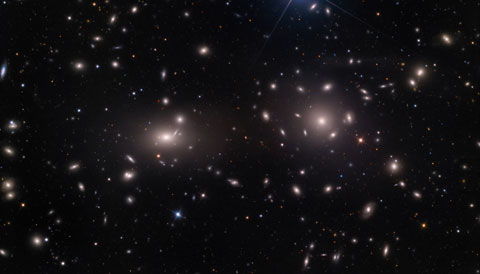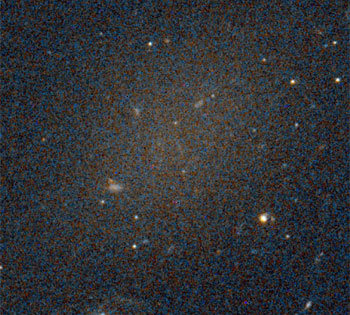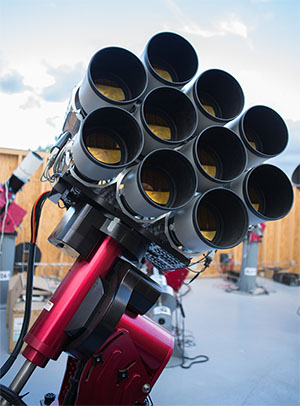A bizarre set of galaxies in the Coma Cluster have lost most of their stars (or star-making material), making them especially rich in dark matter.

Adam Block / Mount Lemmon SkyCenter / University of Arizona
The Coma Cluster, visible in the evening skies of spring and summer, reveals its jewel box to large backyard telescopes: several thousand galaxies sardine-packed into a space only 20 million light-years across.
But there’s more to the Coma Cluster than meets the eye — or the backyard telescope.
Pieter van Dokkum (Yale University) and colleagues took a unique look at Coma through the Dragonfly Telephoto Array, eight Canon telephoto lenses coupled to CCD cameras. The Dragonfly is designed to find faint, fuzzy blobs, but what its images revealed surprised the team.
On Coma’s outskirts lurk 47 galaxies similar in size to the Milky Way — but with 1,000 times fewer stars. To survive in crowded Coma, these dark galaxies must contain 98% dark matter to hold themselves together, much higher than the fraction in the universe at large (83%).
Near or Far?

Pieter van Dokkum & others
The galaxies' size depends on their distance, so to make sure this result wasn’t just a trick of perspective, van Dokkum and colleagues had to make sure these galaxies really belonged to the Coma cluster, more than 300 million light-years away. If they turned out to live nearby, the galaxies' size would be akin to regular ol' dwarf galaxies.
Determining cluster membership was a challenge because the objects are far too faint to study in the usual ways, such as taking a spectrum to determine their distance. Nonetheless, “van Dokkum and his co-authors make quite a convincing case,” says Mark den Brok (University of Utah).
The authors initially expected the galaxies to be distributed randomly, as they would be if they lay in the foreground near the Milky Way. Instead, the galaxies cluster around the center of the image in the cluster’s periphery. The discovery of a serendipitous Hubble image of one of the galaxies strengthened the team’s case, den Brok says, definitively showing that it doesn’t have the traits of a nearby dwarf galaxy.
Starless Galaxies

Dunlap Institute for Astronomy & Astrophysics / University of Toronto
Somehow these weirdly faint galaxies have lost their stars — or they never had many stars in the first place. Van Dokkum and colleagues suggest that these may be “failed” galaxies, having forfeited most of their star-building gas after hosting a first generation of stars.
Simulations that track the evolution of large-scale structure suggest that even normal galaxies start out with three times more star-building material than they develop into stars. So whatever process works to limit star formation in normal galaxies is working particularly well in these dark matter-rich galaxies.
“Our simulations have shown that one way to limit star formation so drastically is to use the energy stars produce when they blow up as supernovae,” says Greg Stinson (Max Planck Institute for Astronomy, Germany). “It turns out that this disruption leads directly to galaxies that look like the ones van Dokkum is seeing.”
“I was actually very much relieved to see Prof. van Dokkum’s paper,” Stinson adds. Dark matter simulations have been producing galaxies with exactly the size and matter distribution that van Dokkum’s team observed, but such galaxies are naturally difficult to observe.
It’s ironic that dark matter-rich galaxies were discovered in Coma, the birthplace of dark matter theory. Observations of the same cluster in 1933 helped Fritz Zwicky (Caltech) first conceive of the invisible matter that shapes the large-scale structure of the universe. Now ever-deeper observations continue to help astronomers understand dark matter’s role in galaxy evolution.
Reference:
Pieter van Dokkum et al. "Forty-Seven Milky Way-Sized, Extremely Diffuse Galaxies in the Coma Cluster." Astrophysical Journal Letters, submitted.
Dark matter is one of the universe's great unknowns. Find out what else we don't know in our special publication, Astronomy's 60 Greatest Mysteries.
 8
8









Comments
Duczmal
November 21, 2014 at 5:18 pm
Nice article, but the Dragonfly Telephoto Array consists of eight Canon 400mm f/2.8 telephoto lenses coupled to eight science-grade commercial CCD cameras, not "eight Canon cameras".
See http://arxiv.org/abs/1401.5473
You must be logged in to post a comment.
Monica YoungPost Author
November 22, 2014 at 11:43 pm
Luiz, you're absolutely right. I've made the corrections to the article.
You must be logged in to post a comment.
Duczmal
November 21, 2014 at 5:26 pm
...and now is using ten lenses.
You must be logged in to post a comment.
Kevin
November 22, 2014 at 2:20 pm
Only in astronomy could you say "only" 20 million light years. Astronomers have to use the term "light year" because of the enormous distances involved in that field of study. With some truly long distances even "AU" falls short.
To convert 20,000,000 light years into miles, simply multiply 20,000,000 x 5,700,000,000,000 (approximately one light year in miles) to get your answer. If I did my math correctly (caveat: I'm not great at math) that ends up being 114,000,000,000,000,000,000 miles!
You must be logged in to post a comment.
Bob Perrin
November 22, 2014 at 10:13 pm
I'm curious. Why are there 10 lenses in the picture when the article says ther are only 8 cameras.
You must be logged in to post a comment.
Jim-Baughman
November 24, 2014 at 1:38 pm
I think there is a confusion in this article about "dark matter". These dark galaxies are dark because they seem to be long past the era of star making, and thus they contain no glowing gas and all their one-time stars have grown dim. This has nothing to do with "dark matter", the mysterious whatzit postulated by science to explain gravity anomalies.
You must be logged in to post a comment.
Monica YoungPost Author
November 24, 2014 at 5:07 pm
Nope, no confusion. As mentioned in the article, the authors calculated the total mass these galaxies would have to have to survive the cluster environment. Then they can measure the stellar mass by the light the galaxies emit. The end result is that 98% of these galaxies' mass is dark matter, much higher than the fraction in the universe at large.
You must be logged in to post a comment.
Alson Wong
November 25, 2014 at 3:17 am
Jim, you're confusing dark matter with dark energy.
You must be logged in to post a comment.
You must be logged in to post a comment.